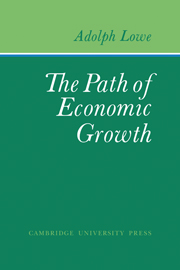Book contents
- Frontmatter
- Contents
- Preface
- Acknowledgments
- PART I The Basic Model
- 1 Introduction: Scope and Method
- 2 Patterns of Economic Growth
- 3 A Schema of Industrial Production
- 4 The Circulation of Fixed Capital
- 5 The Circulation of Working Capital
- 6 The Stationary Process in Operation: Structure Analysis
- 7 The Stationary Process in Operation: Force Analysis
- 8 Transition to Dynamic Equilibrium
- 9 Dynamic Equilibrium: Structure Analysis
- 10 Dynamic Equilibrium: Force Analysis
- PART II Changes in the Rate of Change
- PART III Changes in the Rate of Change
- PART IV Changes in the Rate of Change
- Appendix: An Alternative Presentation of Lowe's Basic Model
- Glossary of Recurring Symbols
- Name Index
- Subject Index
4 - The Circulation of Fixed Capital
Published online by Cambridge University Press: 07 October 2011
- Frontmatter
- Contents
- Preface
- Acknowledgments
- PART I The Basic Model
- 1 Introduction: Scope and Method
- 2 Patterns of Economic Growth
- 3 A Schema of Industrial Production
- 4 The Circulation of Fixed Capital
- 5 The Circulation of Working Capital
- 6 The Stationary Process in Operation: Structure Analysis
- 7 The Stationary Process in Operation: Force Analysis
- 8 Transition to Dynamic Equilibrium
- 9 Dynamic Equilibrium: Structure Analysis
- 10 Dynamic Equilibrium: Force Analysis
- PART II Changes in the Rate of Change
- PART III Changes in the Rate of Change
- PART IV Changes in the Rate of Change
- Appendix: An Alternative Presentation of Lowe's Basic Model
- Glossary of Recurring Symbols
- Name Index
- Subject Index
Summary
So far our schema of industrial production has served as no more than an expository device for a commonsense picture of certain relations between the basic economic stocks and flows. With even a simpler model, J. B. Clark aimed at the same purpose. If his very fruitful suggestions have been eclipsed by the Austrian model of the structure of production, this is probably owing to the fact that Clark did not develop his didactic sketch into an instrument of analysis. This I propose to do now with our schema.
Both the vertical and the horizontal processes described lend themselves to such a transformation, which will provide the tools for our analysis of the capital problems. As a matter of fact, the horizontal processes describe in essence the circulation and, implicitly, also the conditions for the formation of fixed capital, whereas the vertical processes do the same for the working capital. It will be convenient to study the two processes separately and then to combine the results in a comprehensive treatment of the capital problem in a stationary system.
Our first step in transforming our schema into an analytical tool consists in consolidating the various stage inputs and outputs of our three sectors, Ia, Ib, and II, in terms of certain aggregates of finished goods. One group of such aggregates, the outputs of the three sectors, will henceforth be designated a, b, and z, respectively.
- Type
- Chapter
- Information
- The Path of Economic Growth , pp. 35 - 47Publisher: Cambridge University PressPrint publication year: 1976



